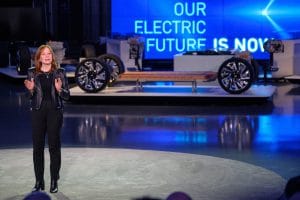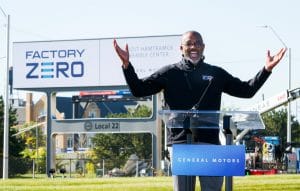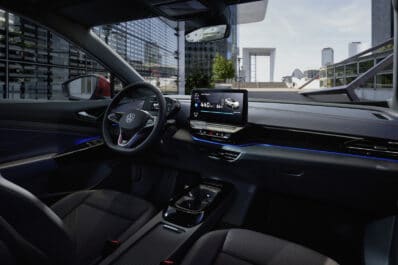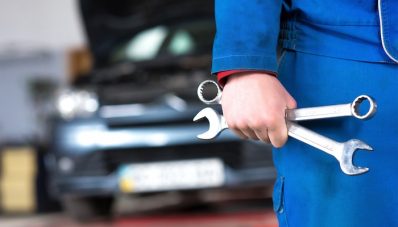
General Motors put some teeth into its promise to go “all-electric” on Thursday, announcing a firm date for that transition, the automaker saying it will completely eliminate all tailpipe emissions by 2035.
The largest U.S. automaker also indicated that it would reach carbon-neutral status across the board, including its vast factory network, by 2040. Thursday’s announcement comes just weeks after GM CEO Mary Barra delivered a keynote address at the Consumer Electronics Show highlighting the company’s expanded plans for its electric vehicle fleet.
“General Motors is joining governments and companies around the globe working to establish a safer, greener and better world,” Barra said in a statement. “We encourage others to follow suit and make a significant impact on our industry and on the economy as a whole.”
(GM, Cruise teaming with Microsoft to speed development.)
For several years, Barra has repeated the mantra that GM “is on a path to an all-electric future,” initially laying out plans to bring 20 battery-electric vehicles to market by 2023. That recently was expanded to 30 BEVs by 2025, with Barra increasing the company’s investment plans for electric and autonomous vehicles to a combined $27 billion.

The list included not only passenger vehicles, such as the new Chevrolet Bolt EUV and GMC Hummer pickup coming to market later this year but also the electric delivery truck to be sold through GM’s new BrightDrop subsidiary.
But, until today, the automaker sidestepped the question of when it would completely eliminate gasoline- and diesel-powered offerings, especially such niche products as the Chevrolet Corvette sports car. According Dane Parker, GM’s environmental director, the automaker will target all light-duty vehicles, which include pickups and SUVs, by the 2035 target date.
GM was one of the first automakers to enter the electric vehicle market several decades back with its short-lived EV1. It received plenty of criticism when it pulled that vehicle from the market, among other things serving as the corporate villain in the documentary “Who Killed the Electric Vehicle?”
The automaker gained some credibility back with environmentalists with the 2010 launch of the Chevrolet Volt, the first mainstream plug-in hybrid, but was again hammered when it initially backed the Trump administration’s plan to strip California of its authority to set emissions standards tougher than federal guidelines.
It recently reversed course, joining Ford, Volkswagen and several other automakers agreeing to an emissions plan compromise with California regulators. And it has joined other corporations in signing onto the Business Ambition Pledge for 1.5 Degrees C, which it describes as “an urgent call to action from a global coalition of UN agencies, business and industry leaders.

(Honda partnering with GM in race to develop self-driving cars.)
The pledge references the target of holding down the global temperature rise due to man-made emissions to 1.5 degrees Celsius. That’s a widely held target that experts believe will limit damage from climate change by, among other things, limiting polar and glacial melt and the rise of the oceans.
The switch that GM and other automakers are planning to all electric vehicles, raises several questions, among them, how the industry will make money on them. Right now, investment into the technology is running into the hundreds of billions of dollars, even Tesla continues to lose money on the production and sale of EVs, its 2020 profits coming solely from the sale of credits.
Parker admitted this is an issue, even though EV costs, in particular battery costs, are coming down as sales grow. While the business case may be questionable right now. “We feel this will be the successful business model of the future,” he said. “We feel we will be able to overcome obstacles (and) be able to thrive in the future.”
Along with eliminating tailpipe emissions – whether through the use of all-electric or fuel-cell technologies – GM also said it will take steps to address emissions from its manufacturing operations. That will see it switch to 100% renewable energy sources in the U.S. by 2030 and by 2035 overseas.
Parker acknowledge what GM is proposing is its “aspirations” and that there will be some challenges. He mentioned, among others, the heating energy for its factories. That could come from renewables, or might require alternative approaches, he said, possibly using hydrogen as a fuel or turning to carbon capture, where the carbon dioxide emissions are collected and then stored to prevent their release into the atmosphere.

“With this extraordinary step forward, GM is making it crystal clear that taking action to eliminate pollution from all new light-duty vehicles by 2035 is an essential element of any automaker’s business plan,” Environmental Defense Fund President Fred Krupp said in the GM statement.
“EDF and GM have had some important differences in the past, but this is a new day in America — one where serious collaboration to achieve transportation electrification, science-based climate progress and equitably shared economic opportunity can move our nation forward.”
GM isn’t the only automaker moving towards a carbon-neutral future. Earlier this week, Nissan CEO Makoto Uchida said his company also plans to get there, but not until 2050.
While the push to electrification is aimed at solving one of the major problems facing the planet, climate change, it poses some other potentially serious problems. These include how to fund transportation infrastructure as funding for that is largely based on gas-tax revenue. Then there’s the issue of jobs. It is widely expected that producing tomorrow’s electric vehicles will require less labor because, among other things, EVs will have fewer parts.
(CEO Barra wants GM to be dominant global EV maker.)
During his Thursday webinar, Parker said GM’s goal is to try to maintain jobs, though he did not say how that might happen. But he also raised another challenge. The switch to electrification there will be less demand for petroleum products, notably gasoline. Parker said GM is already meeting with traditional energy suppliers to discuss their options. He said they are already looking at how they can “repurpose” existing properties, including transforming them from gas stations into charging stations. However, he recognized there will be a need to find other uses for them as well.







